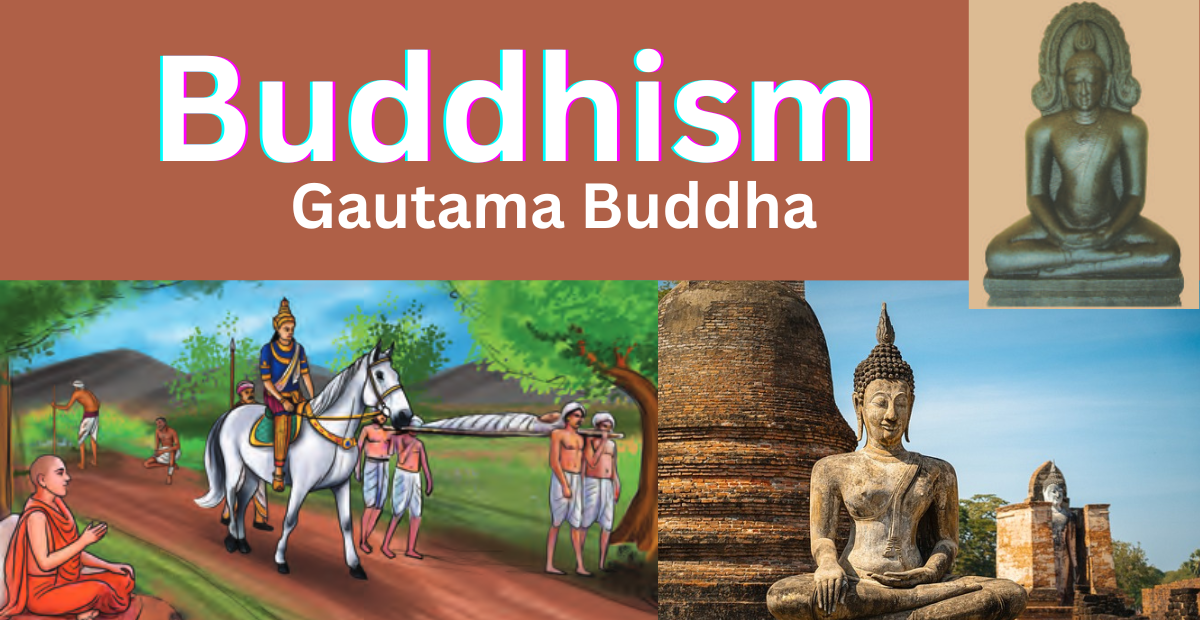Buddhism
Introduction:
The most famous of the religions to solve them is Buddhism, which was patronized by various kings.Its ideas were so lofty that if Ashoka accepted this as the policy of the governmentAlthough Buddhism has disappeared in India for nearly 1000 years, buddhism is still widely practiced in southeast Asian countries.Buddhism was revived in India again in the 20th century by Dr. B.R. Ambedkar.
Gautama Buddha:
Gautama Buddha was the founder of Buddhism. His real name is Siddhartha.Siddhartha was born as the son of Suddhodana and Mayadevi, the king of the Sakya tribe.Gautama Buddha, like Mahavira, was the prince of an ethnic group.Siddhartha’s mother Mayadevi died within seven days of his birth. Therefore, gautami raised him as his aunt.When Gautama Buddha was in the womb, scholars said that “the child who is going to be born will be the emperor of the whole world or the teacher of the whole world”.
Siddhartha was born in a park in Lumbuni near Kapilavasta.Siddhanta’s wife was Yashoda. His son’s name is Rahulan.The name of his charioteer is Channa.One day, while leaving the palace with the charioteer, Siddhartha saw an old woman, a patient, a dead body and a begging department.He then left the palace in the middle of the night in search of a permanent solution to the sufferings of the people.Siddhartha went in search of knowledge and for some time sought guidance from Alarma Kalama and Uttakrama Buddha.One day Gautama Buddha started meditating under a peepal tree in Bodh gaya. After 49 days of meditation, he attained enlightenment.
Buddha was 36 years old when he attained enlightenment.From then on he was called Buddha (meaning one who was enlightened ).He was also known as Sakya Muni as he belonged to the Sakya royal family.The Buddha opposed rituals and questions.He began his first sermon at Sarnath near Varanasi. This is called Dharmachakraparivartana.He then formed associations and spread his ideas to all the villages.He died at the age of eighty in Kushinagar. The death of the Buddha is referred to as parinirvana.
Buddhist Associations:
After the death of The Buddha, buddhist associations were formed and the rules and other matters of Buddhism were resolved through it. Finally four associations took place.
First Buddhist Association:
- It took place during the time of Ajantasatru on the royal planet.
- Upali presided over it. Verbs and pure pits were read.
Second Buddhist Association:
- It was held in Vaishali 100 years after buddha’s death.
- The Sangha was divided into two sections, the Sthaviravatikas and the Mahasangika.
The Third Buddhist Association:
- It was held at Pataliputra under the leadership of Ashoka.
- Those who had anti-religious ideologies were removed from Magadha.
- The last part of the abhi dhamma peetham called kathavathu was included in this association.
Fourth Buddhist Association:
- Held during the Kanishka period in Kashmir
- The organizers of this conference were sarvasthivadis , a section of Buddhism.
Sects of Buddhism:
The main sects of the Mahasanghikas, the Sthavirvatikas and the Sarvastivadis emerged in Buddhism, resulting in the emergence of new ideas.
Mahayana:
- Maha Yanam means ‘big vehicle’ in Sanskrit.
- G. In the first century A.D., they created a unique tradition.
- It emphasizes the Bodhisattva path.
- The teachers wanted buddhism to be attained not only for their own liberation but also for the good of all beings.
- This type of Buddhism was found in important parts of East Asia, including China, Japan, Korea and Vietnam.
Hinayanam:
- Chinese yanam means ‘less vehicle’ in Sanskrit. and is called the ‘School of the Elders‘.
- They focused on the teachings of the Buddha and the liberation through the life of ascetics .
- It reached the strength of Southeast Asia, including Sri Lanka, Thailand, Myanmar and Cambodia.
Vanjarayanam:
- Vanjaraiyaanam means ‘diamond vehicle‘ in Sanskrit. It is considered to be the most powerful path of Buddhism.
- They believed that negative emotions and quick knowledge could be achieved through tantric mantra.
- Tibet, PuStan is practiced in Mongolia and some parts of China.
Buddhist literature:
The literature of Buddhism is written in Pali language.The Buddhist laws in the Pali language were called tripitakas (three baskets). they
Vinaya Pitakam:
- This peetha speaks of the rules and regulations of asceticism.
Pure Pidakam:
This peethagam recites all the teachings of the Buddha.The shuddha pitakam is divided into five parts.
- Digha Nikaya (long lectures)
- Majjima Nikaya (Medium Lectures)
- Samyuttha Nikaya (Attached Discourses)
- Angudhara Nikaya (Number Lectures)
- Kuttaka Nikaya (short collection)
Abidama Pitakam:
- This peeta speaks of all the philosophies of Buddhism .
Mahayana Sutras:
- These sutras are based on Mahayana Buddhism and have formulated the Lotus Sutra, the Heart Sutra and the Diamond Sutra.
The Aour Great truths of The Buddha Are:
- Life is full of all sorrows and sorrows.
- Desire is the main cause of suffering.
- If we cast out desire, all sufferings and sorrows will leave us.
- If you live with self-control and discipline, you can conquer desires.
Buddha’s numerological path:
- Good faith
- Good intentions
- Good talk
- Good deed
- Good Life
- Nice try
- Good knowledge
- Good meditation
Teachings of Buddhism:
The Buddha did not speak or mention God. He neither accepts nor denies that God exists.Buddhism was opposed to caste systems.Buddha’s intoxications are referred to as ‘Dhamma‘.Buddhism accepted Mahavira’s doctrine of karma.The Buddha emphasized to all that the ultimate aim of life is to attain the state of nirvana.Buddha’s vision of the world, he said, was the wheel of life.
The reason for the spread of Buddhism is:
The teachings of the Buddha were very simple.Buddhism rejected elaborate religious rituals.They opposed the costly sacrifices and sacrifices of the Vedic period.The Buddha insisted that people should observe dhamma. By propagating the ideas of Buddha through Buddhist associations.And empires such as Ashoka, Kanishka and Harsha supported Buddhism.A large number of Buddhist viharas or monasteries were taught open education.‘Nalanda University’, the best university , was created by Buddhists.Yuanchuan , a Chinese traveler, studied there for many years.
The decline of Buddhism in India:
With the passage of time, the Buddhist month was divided into more sects .It lost its dominance by dividing it into various divisions such as Hinayana, Mahayana, Vanjarayana, Tantrayana and Sahajayana.In course of time, the messages of Buddhism from Pali and Prakrit were transferred to Sanskrit.Because of this, there was a gap between the common people and Buddhism.Lost the support of kings over time.Later, the spiritualists Ramanuja and Ramananda proposed the Veda which spoke of the glories of the Vedas.Buddhism gained a great deal due to the invasion of the Hinas. The Heena rulers were totally opposed to Buddhism.Rajput rulers were also involved in harassing and harassing.So the Buddhist monks went to Nepal, Diyathai and Sri Lanka, where they had left India , as refuge.As a result, the dominance of Buddhism in India gradually decreased.
Additional information:
Buddhist Temples:
| Temple Name | location | Architectural style | Notable Features | Religious Tradition |
| Mahabodhi Temple | Bodh Gaya, India | Indian and Gupta styles | Bodhi tree, Vajrasana, diamond throne | Theravada and Mahayana |
| Porapudur | Java, Indonesia | Javanese Buddhists | Stupas, bead-shaped reliefs | Mahayanam |
| Swetagon Pagoda | Yangon, Myanmar | Burmese architecture | Gold stupa, diamond orb | Theravada |
| Thodai-G | Nara, Japan | Japanese Buddhism | Great Buddha Hall, Typhutsu | Vajrayanam |
| What Bra Cave | Bangkok, Thailand | Thailand Architecture | Emerald Buddha, the Great Palace | Theravada |
| Swayambunath | Kathmandu, Nepal | Nepali Architecture | Stupa, buddha’s eyes, prayer flags | Vajrayanam |
| Bauddhanath | Kathmandu, Nepal | Nepali Architecture | Massive Stupa, Zoning Design | Vajrayanam |
| Dambulla Cave Temple | Dambulla, Sri Lanka | Architecture of Sri Lanka | Cave complex, Buddha statues | Theravada |
| Hynzah | Kyeongchang, South Korea | Korean Buddhism | Tripitaka Koreana, Janggyeong Panjion | Zion (Zen) |
| Bo Lin Monastery | Landau Island, Hong Kong | Chinese architecture | Tian Tan Buddha, The Path of Knowledge | Mahayanam |





Good
Pingback: Mahajanapadas 16 Mahajanapadas - History Capital & Location